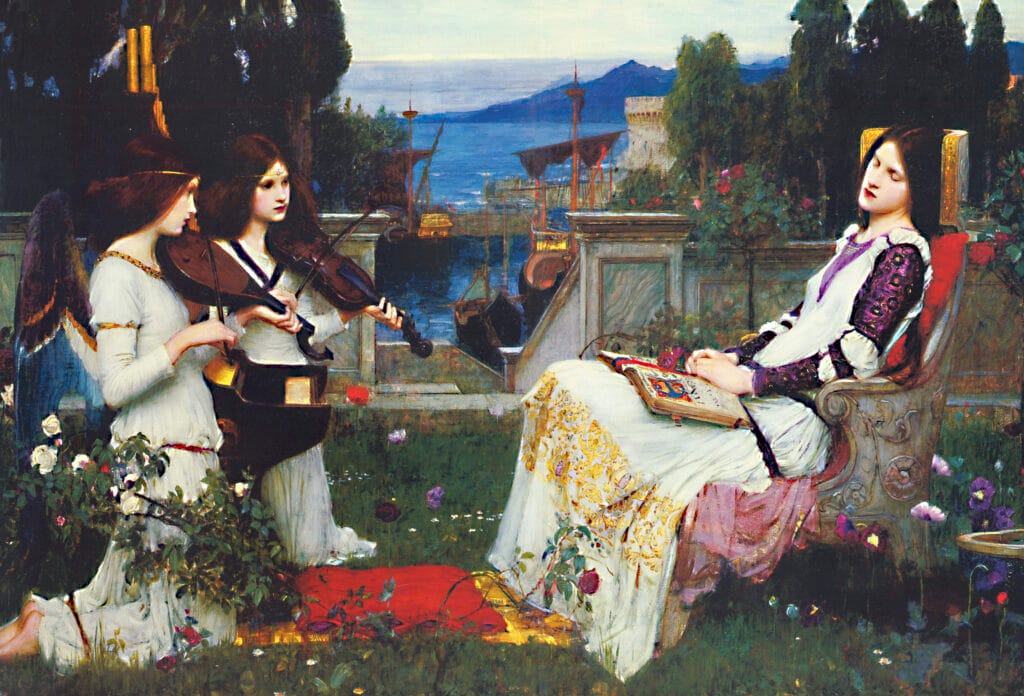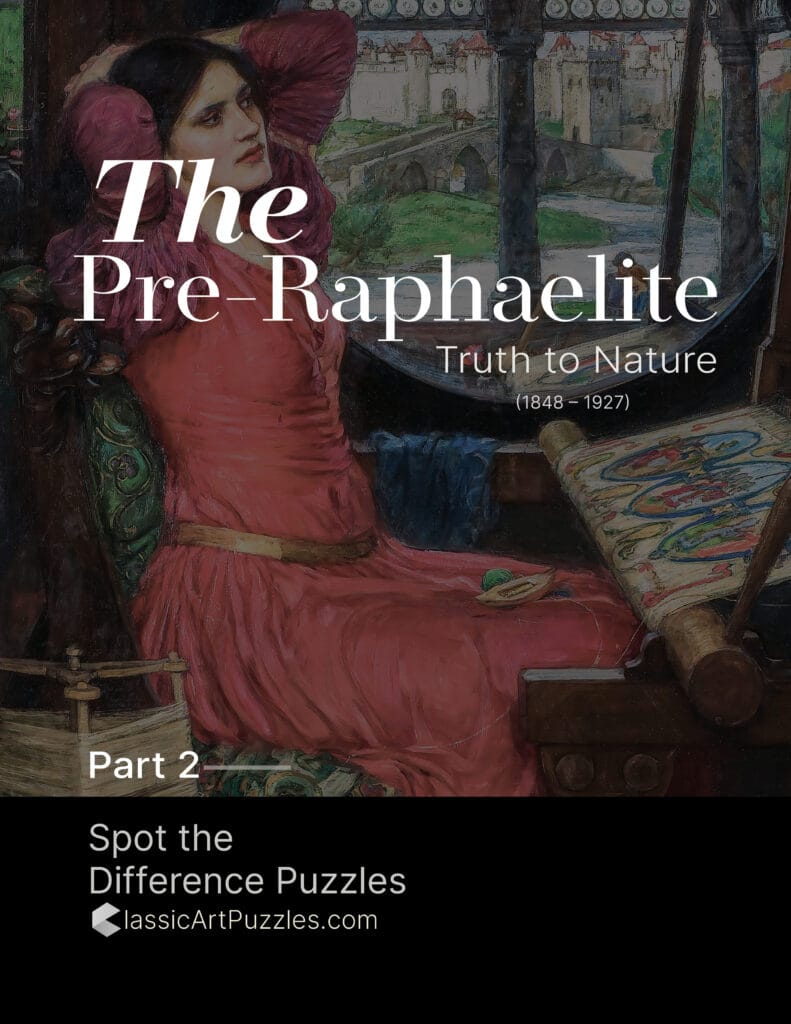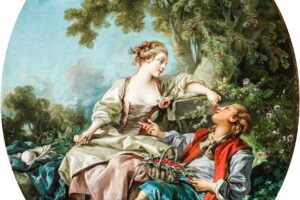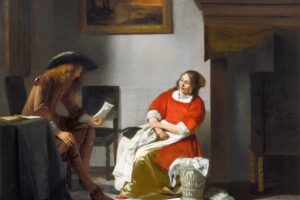Table of Contents
Overview
Diogenes (1882) by John William Waterhouse portrays the ancient Greek philosopher in his most famous guise: dwelling inside a ceramic jar, rejecting wealth and luxury. In the foreground, a group of women dressed in richly colored robes descend marble steps, their parasols and baskets filled with roses symbolizing refinement and worldly pleasure. Yet Diogenes, seated in shadow, clutching a scroll and lamp, remains aloof — the embodiment of disdain for social convention.
John William Waterhouse (1849–1917), though often associated with later Pre-Raphaelitism, brought a distinctly classical approach to his work. In this early painting, he balances narrative realism with allegorical weight, contrasting the Cynic’s austerity with the elegance of passing figures.
When first exhibited at the Royal Academy in 1882, Diogenes intrigued Victorian audiences by merging antiquity with moral lesson. Today, it remains a powerful image of philosophical defiance and the eternal questioning of society’s values.
The Artist
John William Waterhouse (1849–1917) was a British painter whose works bridged Pre-Raphaelite naturalism and classical revival. Known for mythological and literary subjects, he painted with jewel-like color, narrative intensity, and psychological nuance. While later works such as The Lady of Shalott gained enduring fame, earlier pieces like Diogenes reveal his fascination with history, philosophy, and allegory. His career stands as a testament to Victorian art’s transition toward Symbolism.

The Story Behind the Painting
Diogenes the Cynic
Diogenes of Sinope (c. 412–323 BCE) was a Greek philosopher and one of the founders of Cynicism. Rejecting material possessions and social pretenses, he lived simply, often in a barrel or jar, with only a cloak, staff, and lamp. His lamp became symbolic of his search for “an honest man.”
The Contrast of Worlds
Waterhouse depicts Diogenes in his earthen jar, reading by daylight, while above him fashionable women glide past with parasols and baskets of flowers. Their beauty, wealth, and leisure underscore the contrast with his chosen poverty and solitary wisdom.
Victorian Morality
To Victorian viewers, Diogenes symbolized resistance to consumerism, hypocrisy, and vanity. The painting thus served not only as a classical tableau but also as a meditation on the enduring tension between simplicity and excess.
Composition and Subjects
Diogenes in the Jar
At the bottom right, Diogenes sits cross-legged in shadow, his muscular form austere and unadorned. His scroll represents knowledge, while the lamp at his feet recalls his search for truth.
The Women on the Steps
Three women descend the marble stairs, their flowing robes in rose, teal, and white echoing the elegance of antiquity. Parasol and fan in hand, they symbolize refinement and social convention, unaware or indifferent to the philosopher below.
Symbolic Objects
- The Roses: fleeting pleasures of beauty and desire.
- The Lamp: the Cynic’s eternal search for honesty and truth.
- The Scroll: knowledge, enduring even in isolation.
- The Jar: rejection of worldly comfort, the philosopher’s voluntary exile.
Architectural Setting
The marble steps, columns, and bright sky frame the figures in a space of classical grandeur. Yet Diogenes remains half-hidden, emphasizing his distance from society’s gaze.
Art Style and Techniques
Classical Realism
Waterhouse employs meticulous naturalism: flesh tones, fabric folds, and architectural detail are rendered with clarity. This realism grounds the allegory in convincing physicality.
Pre-Raphaelite Influence
Though not a Brotherhood member, Waterhouse echoes their ideals of jewel-like color, narrative precision, and symbolic layering. Every detail carries weight beyond its surface appearance.
Dramatic Contrast
The painting’s heart lies in visual opposition: shadow and sunlight, austerity and luxury, solitude and companionship. This tension embodies the eternal dialogue between philosophy and society.
Legacy and Reflection
Reception in 1882
When first exhibited, Diogenes was praised for its vivid classical scene and moral symbolism. Critics noted Waterhouse’s ability to transform antiquity into a stage for universal human concerns.
Enduring Significance
Today, the painting resonates as a timeless allegory. It invites reflection on how we define value, comfort, and truth, and whether society’s luxuries conceal deeper emptiness. Through Waterhouse’s brush, Diogenes remains as provocative in the 21st century as he was in ancient Athens.
Featured in Our Collection
Diogenes is featured in our Pre-Raphaelite Spot-the-Difference Puzzle Flipbook P2. Its contrast of marble, roses, and shadowed jar makes it a compelling puzzle subject. By engaging with its details, you sharpen focus while reflecting on Waterhouse’s allegory of simplicity versus excess.
The Philosopher in the Jar
A philosopher sits in shadow, women glide above, roses scatter across marble steps. In Diogenes, Waterhouse paints a moment where austerity confronts luxury — a vision of truth hidden within the noise of society.
More About Artist

John William Waterhouse RA (baptized April 6, 1849 – February 10, 1917) was a renowned English painter closely associated with the Pre-Raphaelite style and Victorian Romanticism. Born in Rome to English painter parents, Waterhouse moved to London in childhood, where he was exposed to a rich artistic environment near the Victoria and Albert Museum. He trained at the Royal Academy of Art, initially studying sculpture before switching to painting. Waterhouse became famous for his vibrant, detailed depictions of mythological, literary, and classical subjects, bringing the Pre-Raphaelite aesthetic into the early 20th century.
Artist Style and Movement
Waterhouse’s style bridges Academic art and Pre-Raphaelite influences, characterized by luminous colors, precise detail, and narrative richness. His subjects often derived from classical literature, myths, and poetry—especially works by Tennyson, Shakespeare, and Homer—delivered with romanticism and emotional intensity. He focused on female protagonists, enchantresses, and tragic heroines, exploring themes of love, fate, and destiny. Though rooted in Victorian ideals, his brushwork sometimes reflected Impressionist influences.
Artwork Profile
- After the Dance (1876): An early success capturing a courtly scene post-dance with refined detail and vibrant colors.
- A Sick Child Brought Into the Temple of Aesculapius (1877): A dramatic and poignant painting reflecting ancient themes of healing and faith.
- Diogenes (1882): A philosophical portrait of the Cynic philosopher Diogenes, embodying simplicity and defiance.
- The Favourites of the Emperor Honorius (1883): A richly detailed historical scene depicting imperial court life.
- Consulting the Oracle (1884): An evocative scene emphasizing Greek antiquity and mysticism.
- The North-West Passage (1874): A patriotic narrative painting recalling British exploration.
- Penelope and the Suitors (1912): Reflects Waterhouse’s fascination with Homeric epics, childbirth, and female virtues.
- “Am Half-Sick of Shadows,” Said the Lady of Shalott (1915): A late portrayal of Tennyson’s tragic heroine, encapsulating Waterhouse’s romantic and symbolic style.
John William Waterhouse’s enduring legacy lies in his masterful synthesis of Pre-Raphaelite romanticism and Victorian poetic storytelling. His paintings display an exquisite balance of detailed craftsmanship and emotional narrative, making him one of the last significant bearers of the Pre-Raphaelite tradition into the 20th century. His works continue to captivate with their rich color palettes, mythic themes, and profound human emotions.




